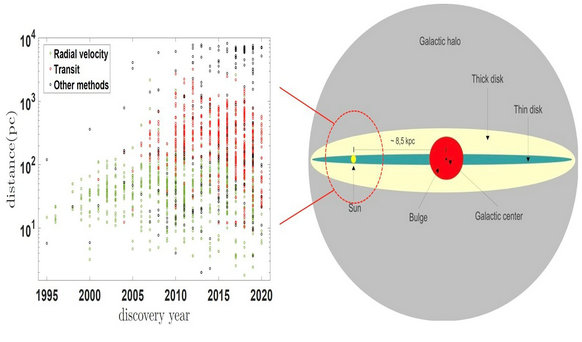Planetary Census "Through" Time and Space Aided by LAMOST
An international research team, consisting of astronomers from the institutes and universities in China and the United States, has conducted a census of exoplanets in the Milky Way and carried out a series of researches with the subject "Planets Across Space and Time" (PAST), using the data of LAMOST, Gaia, Kepler and etc.
The first two works of the series (PAST-1 and PAST-2) have been published in the Astrophysical Journal and the Astronomical Journal, respectively.
To date, over 4000 exoplanets have been discovered and thousands of candidates are yet to be confirmed. Thanks to the improvement of observational technology, the discovered exoplanet population has expanded significantly from the solar neighborhood to a much larger area (orders of 1000 pc) in the Galaxy (see Figure 1). We are therefore entering a new era to study exoplanets in the Milky Way.
In the Galactic context, one of the fundamental questions in studying exoplanets is: what are the differences in the properties of planetary systems at different positions in the Galaxy with different ages? The answer to this question will provide key insights on the formation and evolution of the ubiquitous and diverse exoplanets in different Galactic environments.

Figure 1: The distribution of known planets in the Milky Way. (Image by Di-Chang Chen)
To address this question, the first step is to characterize the Galactic components and ages of the planet host stars. However, most exoplanet host stars have no (accurate) age estimates and the kinematic method to obtain Galactic components is limited within the solar neighborhood (~100 pc).
In order to cover most known planet hosts, based on LAMOST and Gaia data, the team revisited the kinematic method for Galactic component classification in the first paper of the PAST series (PAST-1), and extended its applicable range from ~100 pc to ~1500 pc from the Sun. Furthermore, the team revised the age-velocity dispersion relation and reduced the typical uncertainty in measuring kinematic age from ~30-60% to ~10-20%.
Applying the revised methods, in the second paper (PAST-2), the team constructed catalogs of 2174 planet hosts and 35,864 Kepler stars with kinematic characterizations (e.g., Galacto-centric positions, velocities and component membership, Figure 2) as well as other physical properties (e.g., effective temperature and metallicity) by combining data from LAMOST, Gaia, Kepler and etc.

Figure 2: The Toomre diagram for LAMOST-Gaia-Kepler stars. (Chen et al. 2021, AJ)
They found that the fraction of thin (thick) disk stars increases (decreases) with transiting planet multiplicity (Np) and the kinematic age decreases with Np (Figure 3). "This suggests that planetary systems, especially for multiple planetary systems, favor young and thin disk stars. The results provide insights into the formation and evolution of planetary systems with the Galactic components and stellar age," said Dr. Di-Chang Chen from Nanjing University, the lead author of the paper.

Figure 3: Fraction of thin disk stars (top), thick disk stars (middle) and kinematic age (bottom) vs. the number of planets detected around the star (Np). (Chen et al. 2021, AJ)
The revised kinematic methods and the stellar catalogs of kinematic properties and ages obtained in PAST-1 and PAST-2 lay the foundation for future studies of exoplanets in space and time in the Galactic context. Based on them, several subsequent works of the PAST series are in process and preparation.
The serial papers can be accessed at:
PAST-1: https://iopscience.iop.org/article/10.3847/1538-4357/abd5be
PAST-2: https://iopscience.iop.org/article/10.3847/1538-3881/ac0f08